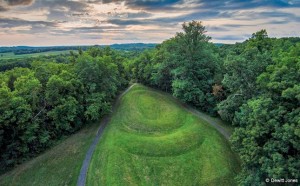Dec 5, 2014
Flying High at Serpent Mound State Memorial

Cruising along near Peebles, Ohio. Lovely countryside, but hardly wilderness. Corn as high as an elephant’s eye, well-kept farms, green deciduous trees—all quite a change from the wide-open western landscapes I’m accustomed to. It’s bucolic, but quite immediate, and very human-centered. I missed the sense of immense time I feel when staring at the layered rocks of the Grand Canyon, or the feeling of immense space in the Rockies or the Sierra. I know this landscape is just as old and, indeed, just as vast, but surrounded by trees and man-made structures, I’m just not feeling it.
My host turns right at a sign announcing Serpent Mound State Memorial. We park, grab our gear, walk past the small visitor’s center and head down a trail toward the mound. Very quickly, things begin to change. The further I go down the trail—the closer I get to the mound—the more I’m enveloped by a palpable sense of peacefulness. Not just the peacefulness of a wooded trail, no, stronger and more focused. Humanly spiritual.
We round a corner and the great serpent stretches before us. For almost 1,400 feet, this great grass-covered snake glides beneath the overhanging trees. I know nothing of its history or purpose (I hadn’t read the signs or brochures) but, oh, I can feel it. Humanly spiritual and very old. I remember the same feeling surrounding me when I spent the night in Chaco Canyon and sat with the stars overlooking Pueblo Bonito.
We walk silently by the great coiled tail and down past the three giant coils of the serpent’s body. Signs tell me that the apex of each coil aligns with various celestial markers—the moon and the sun at the equinox and solstice events of the year.
Built almost 1,000 years ago by the Fort Ancient people, the serpent is astrologically amazing, stunningly beautiful and vibrationally mesmerizing. It’s hard to take it all in from ground level, so the kind keepers of the park built a 25-foot-high observation tower. I sit atop it for almost an hour just drinking in the view (photo #2, below, an iPhone panorama).
Now I’m connected to time and the land in the way I was missing on the drive out. I let the spirit of the place permeate me. My eye traces the body of the serpent again and again.
But there’s still a niggling in my peacefulness; something is missing. Finally, it comes to me. Grand as this vista is, I can’t see the head of the serpent. If the tower were 100 feet high, perhaps, but not from here. Yes, an hour ago, I had walked beside this great head, but it was hard to get a sense of it from ground level and, now, it’s beyond my view.
Ah, but in the trunk of the car is a piece of technology that just might allow me to find the vantage point I seek: my DJI Phantom 2 Vision quadcopter.
Quadcopter photography. That’s a subject worth several columns’ worth of words. Copters have given us images that previously we could only dream of and have presented us with ethical, moral and legal decisions that, indeed, we never dreamed of. I’m just beginning to use mine, but I’ll share with you what I’ve learned so far: 1) Really learn to fly before you start taking pictures; 2) When in doubt, ask permission; and 3) Use common sense as to when and where you fly. (One unconscious photographer just crashed his drone into the Grand Prismatic Spring in Yellowstone, causing the Park Service to further harden their ban on drone use within the parks.)
So I checked with the memorial for permission and waited until just before closing when almost all of the visitors had left the site. Then I took the copter down the path to the head of the serpent and launched it into the air. On the screen of my iPhone (seeing through the camera on the copter), a wonderful image appeared. There’s the mouth of the serpent, its jaws holding a giant orb. Beyond, the soft hues of a Midwestern sunset. Was I looking at a view from today or 1,000 years ago?
I clicked the shutter, brought my copter down, packed up and headed out of the memorial just before the gates closed. That evening, before my computer, I relived the experience all over again.
I hang in the air above the serpent’s giant head, feel the power of its being—how it changed and expanded the landscape for me. Finally, I murmur a prayer of gratitude that places like this are preserved and that I, as a photographer, can both capture and experience them. “Thank you!”
Author’s Note: Serpent Mound is on the Tentative List to be nominated as a World Heritage Site.
Speaker
Tags

 Dewitt Jones
Dewitt Jones